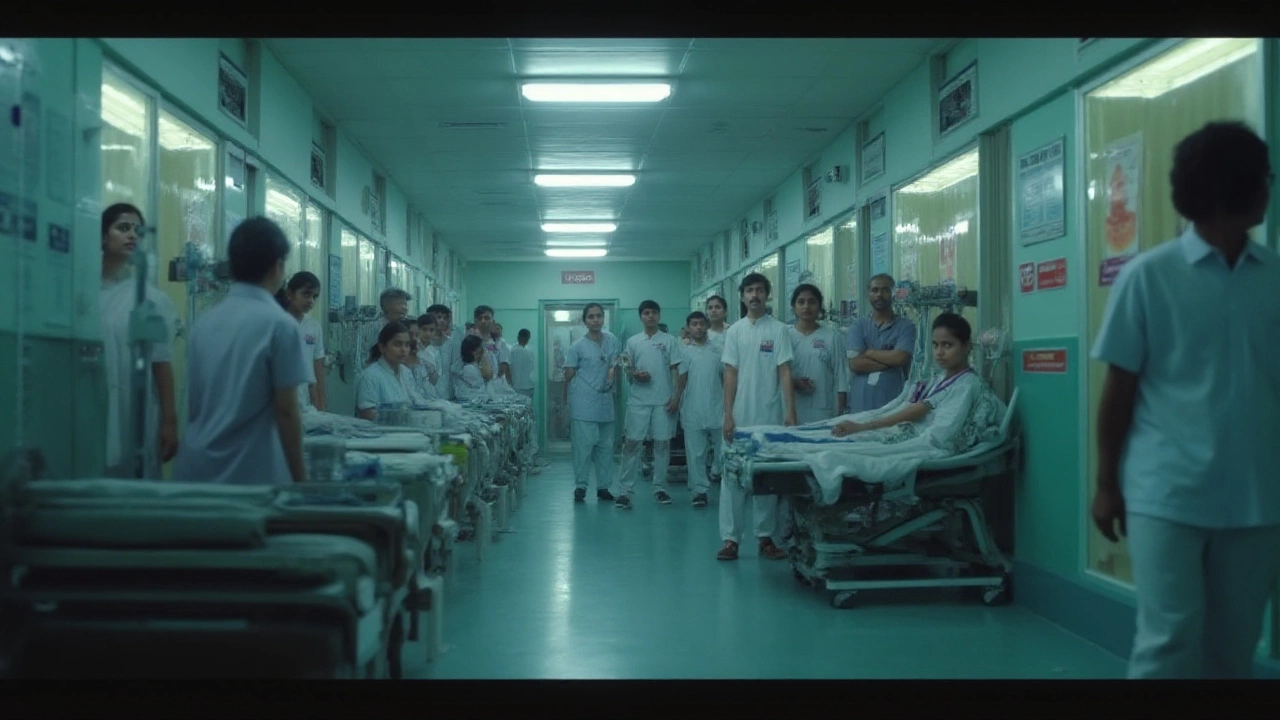Imagine this—you feel healthy one month, but just a few weeks later you’re handed a terrifying diagnosis. Hours slip into days, days slip into weeks, and it feels like the ground is falling out from under your feet. Fast-killing cancers work at ruthless speed, leaving little breathing room for answers or hope. If you think all cancers move at a crawl, these aggressive types break every rule—and they aren’t shy about it. Knowing which ones they are, what early warning signs to look for, and why they act so brutishly is a genuine life-saver. This isn’t about fear-mongering—it’s about shining some light on the cancers that don’t play fair.
What Defines the "Fastest Killing" Cancers?
People often assume the deadliest cancers are just those that eventually take the most lives. It’s not that simple. The so-called "fastest killing cancers" aren’t necessarily the ones with biggest death tolls—they’re the ones that can go from subtle symptoms to life-threatening in record time. For many of these, the window between feeling normal and being in serious danger is shockingly brief. A cancer can be deadly if it moves in, grows rapidly, and overwhelms the body before typical treatments have a fighting chance.
Let’s get straight to it—pancreatic cancer tops most lists; it’s widely known for its aggressive speed and lack of noticeable symptoms until it’s way too late. Patients can go from fine to terminal diagnosis in a heartbeat, and the odds of surviving five years are staggeringly dim—just 12% in 2025, according to the American Cancer Society. Why so bad? First, its symptoms are vague: back pain, weight loss, mild stomach discomfort—stuff most people brush off. Second, the pancreas sits tucked away behind vital organs, meaning by the time you catch it, it’s likely spread all over. Third, these cancer cells seem born to migrate. They climb into nearby blood vessels and lymph nodes like they’re checking off a to-do list.
Another speed demon? Small cell lung cancer. There are two main types of lung cancer, but “small cell” is like the evil twin—double the aggression, double the invasion. You might cough for a few weeks and think it’s a cold, then suddenly it spirals, with tumors spreading to the brain, bones, or liver before you even get a CT scan. No wonder its 5-year survival rate hovers around a brutal 6%. Most cases are tied to heavy smoking, but not every patient fits the stereotype.
Some other cancers famous for their breakneck speed include brain cancers like glioblastoma, certain liver cancers, and esophageal cancer. These are less common, but when they do hit, they hit hard and often in younger, seemingly healthy people. The median survival for glioblastoma, for example, is only 12 to 18 months—even with the best, most modern treatments.
If you look at the numbers, these cancers show up alarmingly quickly. Take a look at the following table showing average 5-year survival rates for some of the fastest killing cancers, based on recent data:
| Cancer Type | 5-Year Survival Rate | Median Survival (Months) |
|---|---|---|
| Pancreatic cancer | 12% | 6-11 |
| Small cell lung cancer | 6% | 8-15 |
| Glioblastoma (brain) | 6.8% | 12-18 |
| Liver cancer | 21% | 6-20 |
| Esophageal cancer | 20% | 12-20 |
It’s gut-wrenching to see numbers like these on paper, but knowing which cancers strike the fastest helps you draw a map of where to keep your guard up. Quick-moving cancers are so dangerous because catching them early is tough—they grow fast and quietly, often with non-specific or silent beginnings.

Hidden Symptoms, Razor-Thin Timelines: Why Fast-Killing Cancers Are Tricky
The reason these cancers snatch lives so quickly isn’t just their biological aggression—it’s also how they play hide and seek with symptoms. You probably wouldn’t sound the alarm for vague back pain, a little weight loss, or a low-grade cough. Yet, that’s how these cancers sneak up on people. You get used to the nagging signs and chalk them up to something minor—stress, overwork, maybe a bad meal or a lingering cold. By the time you sense that something’s really off, the cancer’s already on the move.
Check out some red flags that often get missed or misread:
- Persistent, unexplained pain—especially in the back, belly, or chest
- Sneaky weight loss without diet changes
- Constant tiredness no matter how much you rest
- Jaundice (yellowing skin and eyes)—an early sign for pancreatic and liver cancers
- Loss of appetite, even for foods you usually like
- Cough or hoarseness that drags on for weeks
- Headaches with vision changes (possible with brain cancers)
What’s truly alarming is how fast these cancers can take over. Pancreatic tumors, for instance, double their size in just over a month. That’s lightning fast compared to most tumors. Small cell lung cancer, on the other hand, is like gasoline on a fire in your body—it can take over the other lung, then move to the bones or brain in no time.
Spotting these symptoms early is tough, but your best defense is to tune in to your own body. If something feels truly different—and it lasts longer than two weeks—don’t brush it off. A lot of these cancers are still most common in people over 50, but cases in younger people are climbing. Years ago, doctors barely saw pancreatic cancer in people under 40, but it’s not rare anymore. One 2024 review from The Lancet even flagged rising aggressive cancers in adults as young as their late 20s, so playing the age card isn’t safe anymore.
Awareness is even trickier for smokers or drinkers, but you’d be surprised—about 10-20% of new pancreatic cancer cases are in people with zero family history and few risk factors. No lifestyle guarantees immunity.
Blood work and most basic scans often show nothing until late stages, which is why many experts now push for earlier screening for high-risk people. MRI, CT, or PET scans can sometimes catch tumors when they’re smaller, but insurance rarely covers these until you already have scary symptoms. Genetic testing for BRCA mutations and new liquid biopsy blood tests are just starting to save lives—these could become normal annual checks for future generations.

Can You Outsmart the Fastest Killing Cancers? Real-World Tips and Hope on the Horizon
If you Google “fastest killing cancer,” the news scroll can look bleak. But here’s the honest twist: survival is possible, especially if you spot things early and move quickly. There are some real-life steps you can take, and more hope coming from science every year.
Here’s what actually makes a difference—concrete steps, not internet rumors:
- Listen to your body and push back against “it’s nothing” instincts if a weird symptom sticks around.
- Don’t ignore family history. If you have relatives with pancreatic, breast, or ovarian cancer, ask your doctor about earlier or more aggressive screening—especially if anyone had cancer before age 50.
- If you smoke, quit. Nothing slashes small cell lung and pancreatic cancer risks more than kicking the habit. Even 5 years off cigarettes halves your risk.
- Alcohol is a big risk factor for liver and esophageal cancer—try to stick to healthy limits, or cut it out entirely if you’ve got liver trouble on your medical chart.
- Obesity is a key risk for pancreatic and liver cancer. Just losing 5-10% of your body weight can shrink your risk by up to 30% in some studies.
- Get vaccinated against hepatitis B and get checked for hepatitis C—both are stealthy triggers for liver cancers.
- Push for scans if you develop major symptoms, and don’t be afraid to demand a second opinion.
Scientists are pushing hard. Blood-based cancer screening (sometimes called "liquid biopsy") is a real breakthrough. It finds early cancer DNA fragments in the blood, and you could see these tests in every annual checkup in a few years. Artificial intelligence is also quietly changing how radiologists read scans—AI already helps spot small pancreatic and brain tumors that human eyes miss. Drug research has shifted too, focusing on immunotherapy and targeted treatments that work on even the wildest cancer cells, like those in small cell lung cancer and glioblastoma. There was a huge leap in 2024, when a new combo treatment added nearly six months to the average glioblastoma survival in a large European trial. It’s slow, steady progress, but it’s proof that things aren’t standing still.
Cancer survival stories are honest now, rather than always “beating it.” For those hit by the fastest killers, aggressive care and direct questions can help patients stay ahead, even when the outlook looks bleak. That means seeing an oncologist fast, exploring clinical trials as soon as possible, and building a support network that doesn’t disappear when things get rough. There’s no sugar-coating the risks, but hope lives in information, action, and the willingness to demand answers before time runs out. Fast-killing cancers don’t have to be invisible terrors anymore.





Write a comment